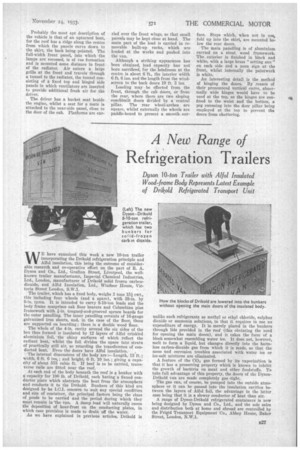A New Range of
Page 37

If you've noticed an error in this article please click here to report it so we can fix it.
Refrigeration Trailers
Dyson 10-ton Trailer with Alfol Insulated Wood-frame Body Represents Latest Example of Drikold Refrigerated Transport Unit
WE have examined this week a new 10-ton trailer incorporating the Drikold refrigeration principle and Alfol insulation, this being the outcome of considerable research and co-operative effort on the part of R. A. Dyson and Co., Ltd., Grafton Street, Liverpool, the wellknown trailer manufacturer, Imperial Chemical Industries, Ltd., London, manufacturer of Drikold solid frozen carbondioxide, and Alfol Insulation, Ltd., Windsor House, Victoria Street London, SAVA.
The trailer, which has a fixed body, weighs 3 tons 15} cwt., this including four wheels (and a spare), with 38-in. by 9-in. tyres. It is intended to carry 8-10-ton loads and the body frame comprises oak floor bearers and Columbian pine framework with Fin. tongued-and-grooved spruce boards for the outer panelling. The inner panelling consists of 16-gauge galvanized iron sheets, and, in the case of the floor, these are supported on boarding ; there is a double wood floor.
The whole of the 4-in, cavity around the six sides of the box thus formed is insulated by 12 layers of Alfol crinkled aluminium foil, the shiny surfaces of which reflect the radiant heat, whilst the foil divides the space into strata of practically still air, so retarding the transference of conducted heat. Even the doors have Alfol insulation. .
The internal dimensions of the body are :—Length, 13 ft.; width, 6 ft. 6 ins.; and height, 6 ft. 10 ins. ; giving a capacity of about 575 cubic ft. If beef is to be carried, transverse rails are fitted near the roof.
At each end of the body beneath the roof is a bunker with a capacity for 100 lb. of Drikold, each having a finned conductor plate which abstracts the heat from the atmosphere and conducts it to the Drikold. Bunkers of this kind are designed by he I.C.I. concern to suit any special condition and size of container, the principal factors being the class of goods to be carried and the period during which they must remain in-the van. A damp load Will naturally cause the deposition of hoar-frost on the conducting plates, in which ease provision is made to drain off the water.
As we have explained in previous articles, Drikold is unlike such refrigerants as methyl or ethyl chloride, sulphur dioxide or ammonia solutions, in that it requires in use no expenditure of energy. It ismerely placed in the bunkers through lids provided in the roof (this obviating the need for opening the main doors), and it takes the form of a block somewhat resembling water ice. It does not, however, melt to form a liquid, but changes directly into the harmless carbon-dioxide gas from which it is made, so that the mess and corrosion troubles associated with water ice or ice-salt mixtures are eliminated.
A feature of the CCia gas formed by its vaporizalion is that it has a preserving property which is known to inhibit the growth of bacteria on meat and other foodstuffs. To take full advantage of this property, the doors of the DysonDrikold van are made completely gas -tight.
The gas can, of course, be pumped into the outside atmosphere or it can be passed into the insulation cavities between the layers of Alfa foil, the advantage in the latter case being that it is a slower conductor of heat than air.
A range of Dyson-Drikold refrigerated containers is now being designed by Dyson and Co., Ltd., and the sole sales and distribution both at home and abroad are controlled by the Frigid Transport Equipment Co., Abbey House, Baker Street, Loudon, N.W.1.




















































































